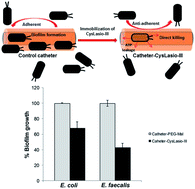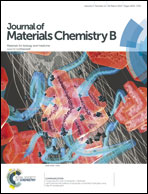Site specific immobilization of a potent antimicrobial peptide onto silicone catheters: evaluation against urinary tract infection pathogens†
Abstract
Bacterial colonization of urinary catheters is a common problem leading to Catheter Associated Urinary Tract Infections (CAUTIs) in patients, which result in high treatment costs and associated complications. Due to the advantages of antimicrobial peptides (AMPs) compared to most other antimicrobial molecules, an increasing number of AMP-coated surfaces is being developed but their efficacy is hindered by suboptimal coating methods and loss of peptide activity upon surface tethering. This study aims to address this issue by employing a methodic approach that combines a simple selective chemical immobilization platform developed on a silicone catheter with the choice of a potent AMP, Lasioglossin-III (Lasio-III), to allow site specific immobilization of Lasio-III at an effective surface concentration. The Lasio-III peptide was chemically modified at the N-terminal with a cysteine residue to facilitate cysteine-directed immobilization of the peptide onto a commercial silicone catheter surface via a combination of an allyl glycidyl ether (AGE) brush and polyethylene glycol (PEG) based chemical coupling. The amount of immobilized peptide was determined to be 6.59 ± 0.89 μg cm−2 by Sulfo-SDTB assay. The AMP-coated catheter showed good antimicrobial activity against both Gram positive and negative bacteria. The antimicrobial properties of the AMP-coated catheter were sustained for at least 4 days post-incubation in a physiologically relevant environment and artificial urine and prevented the biofilm growth of E. coli and E. faecalis. Adenosine tri-phosphate leakage and propidium iodide fluorescence studies further confirmed the membranolytic mode of action of the immobilized peptide. To the best of our knowledge, this is the first proof-of-concept study that reports the efficacy of AMP immobilization by sulfhydryl coupling on a real catheter surface.


 Please wait while we load your content...
Please wait while we load your content...